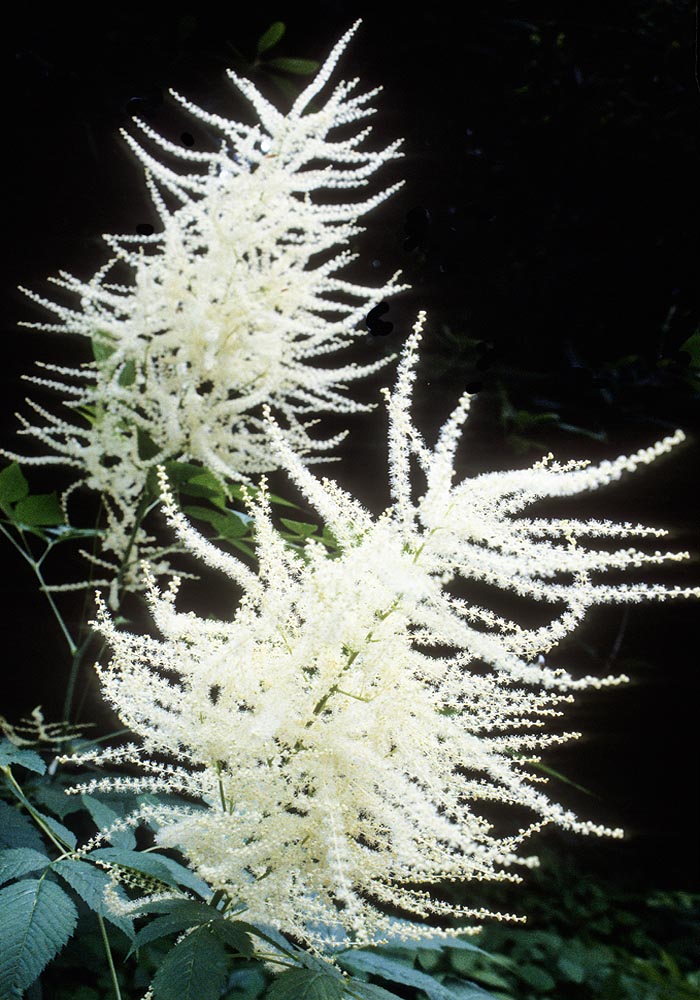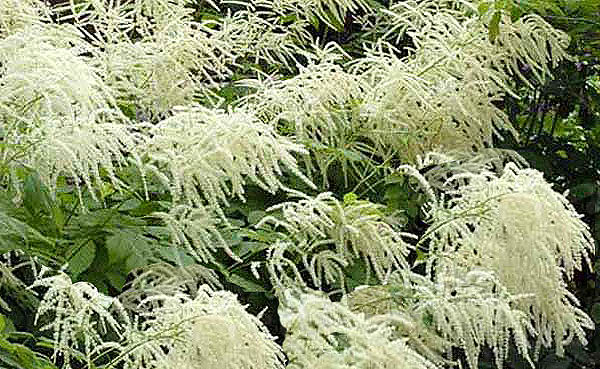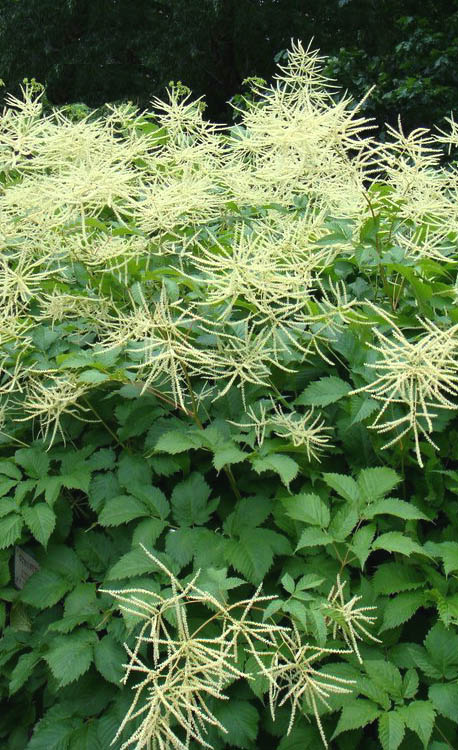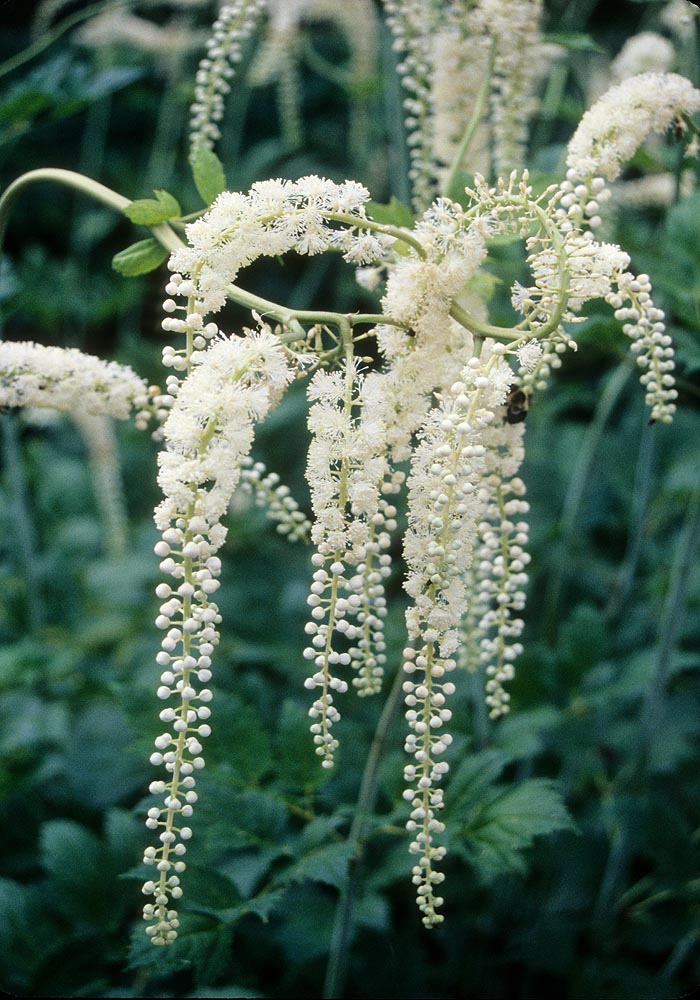Large showy plant for shady and woodland areas that are slightly damp. Very Hardy to zone 3. While not a dense shade plant Goats beard will happily grow in open decidious woodlands, and other shaded areas that have moistures. It likes soil that is always moist but not waterlogged so its great for shady gardens, along stream or pond edges, woodland edges or just about anywhere there is shade. It will grow in most shade areas if its given extra water. It needs a lot of space but rewards with lots of showy white flowers that can reach 6 feet (1.8m) in height in early summer. Once established it takes little care other than a seasonal cut down and can brighten shady areas will little or now work. Butterflies love it but wildlife don't eat it. Great addition to any garden with shade.
Goat's Beard plants are unisexual meaning there are male and female plants, so the flowers on each are different, but the same size although they don't look it. Each have several tiny white petals evenly spaced around the flower center. Each is no more than (1.5mm) long. In the female these are more noticeable as they surround the large central green stigma. In the male flowers the petals are far outshone by the much longer 0.25 inches (6mm) stamens that are a shimmering white with large circular pollen clusters at the end. For this reason male flowers are far more showy and attractive to humans than the female flowers, which have only nectar glands to attract the pollinating insects.
The fruits occur only on the female plants and are up to 2.2 mm long narrowly ribbed and oblong. These turn from green to brown as they ripen in autumn.
Unfortunately plants are rarely labeled as male or female if purchased in a nursery so you just have to plant and wait for them to flower.
Seeds need a period of cold before they will germinate. All our seeds are kept in cold conditions so this part of the process is already underway. Once you receive your seeds place them in the refrigerator immediately and leave them there until ready to sow. These seeds need slightly cooler conditions that other seeds between 55 - 65F (12.7-18.3 C) seems to produce the best results but germination can still take 3-4 weeks.
If nothing has germinated after this time period of moist stratifying is recommended. To achieve this follow our stratification instructions and choose a method that is best suited to your needs.
If you consider its too late in the season to do this, carefully remove the seeds from the potting soil. Place in a paper envelope label it and place in the refrigerator and plant in the fall or early winter.
Best sown in small individual pots or cell trays. repot carefully once the seedlings are large enough to handle and place outside to harden off in shade once plants reach 2 inches(5cm) or more. Then transplant to garden. For more information on growing from seed see our General Growing Instructions.
In cooler zones there is usually less light so it can be grown out in full sun in zones 3-4,some partial shade is suggested for zone 5 and once in zone 6 it acts as a good woodland edge plant or north sides of buildings. Moving south into zone 8 its going to need a lot more shade and water as it does not tolerate the heat as well. Plant somewhere there are plenty of breezes to keep the plant as cool as possible.
In all cases the plants do best in rich soils that have plenty of organic material and moisture. They are good for pond edges moist woodlands or the edges of boggy areas. Does best on soil types that retain water but it will grow in almost any kind of soil provided you add organic material and water it. In areas where the soil is more well drained a soaker hose around the base of the plants is recommended it can be left in place all the time and just used when there is not sufficient rain to sustain the plants. If there is insufficient water the foliage will dry out and turn brown, while plants do recover from low water it can take a while if foliage has died back.
Plants can spread out to 3-4 feet (1-1.2 m) so they need enough room to grow. They are also tall so back borders or their own space in a woodland area is recommended.
Unless you just want bright showy plants space your goats beard at about 3 feet apart, water in well and keep moist at all times. Plants can take at least year to establish and may not flower until the second or even third year.
If you care only about showy plants you may want to plant a little closer together then remove the female plants as you identify them from flowering thus giving the males more room to spread.
It can take Goat's beard a while to establish itself and begin to perform at its best so don't expect spectacular displays until at least year 3. These plants establish strong root systems and don't like to be moved so ensure you have chosen your location well as moving them could stunt growth for many years.
Once its established Goats beard takes little care or maintenance except watering in less moist areas and cutting down foliage before next years growth. Female seed heads may be left for the birds to feed on and add winter interest.
The leaves produce Cyanogenic glycosides which deter wildlife from eating them, even the slugs ignore it.
Female plant seed pods make good dried flower accent.









